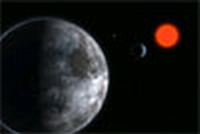Login form
Super Earth
 An Earth-like planet spotted outside our solar system is the first found that could support liquid water and harbor life, scientists announced today. Liquid water is a key ingredient for life as we know it. The newfound planet is located at the "Goldilocks" distance-not too close and not too far from its star to keep water on its surface from freezing or vaporizing away.And while astronomers are not yet able to look for signs of biology on the planet, the discovery is a milestone in planet detection and the search for extraterrestrial life, one with the potential to profoundly change our outlook on the universe.The goal is to find life on a planet like the Earth around a star like the Sun. This is a step in that direction.Each time you go one step forward you are very happy.
An Earth-like planet spotted outside our solar system is the first found that could support liquid water and harbor life, scientists announced today. Liquid water is a key ingredient for life as we know it. The newfound planet is located at the "Goldilocks" distance-not too close and not too far from its star to keep water on its surface from freezing or vaporizing away.And while astronomers are not yet able to look for signs of biology on the planet, the discovery is a milestone in planet detection and the search for extraterrestrial life, one with the potential to profoundly change our outlook on the universe.The goal is to find life on a planet like the Earth around a star like the Sun. This is a step in that direction.Each time you go one step forward you are very happy.
The planet is about 1.5 times larger than the Earth and has about five times more mass than the Earth.. The new "super-Earth" is called Gliese 581 C, after its star, Gliese 581, a star is in the constellation Libra. It is one of one-hundred stars that are closest to the Earth. Its distance of 20.5 light-years (LYs) away makes it about 123 trillion miles (205 trillion kilometers) from the Earth. (One light-year is the distance that light travels in vacuum in one year—a distance of about 6 trillion miles, or 10 trillion kilometers.) In addition, the star is about one third the size of the Sun. Also orbiting Gliese 581 is a larger planet, Gliese 581 b, which is about the size of the planet Neptune. It was discovered on November 30, 2005 by a team of Swiss and French astronomers. The planet Neptune, the eighth farthest planet from the Sun, is about 17 times more massive than the Earth.Gliese 581 C is the smallest extrasolar planet, or "exoplanet," discovered to date. It is located about 15 times closer to its star than Earth is to the Sun; one year on the planet is equal to 13 Earth days. Because red dwarfs, also known as M dwarfs, are about 50 times dimmer than the Sun and much cooler, their planets can orbit much closer to them while still remaining within their habitable zones, the spherical region around a star within which a planet's temperature can sustain liquid water on its surface.Computer models predict Gliese 581 C is either a rocky planet like Earth or a waterworld covered entirely by oceans. The temperature of this super-Earth lies between 0 and 40 degrees Celsius [32 to 104 degrees Fahrenheit], and water would thus be liquid.

